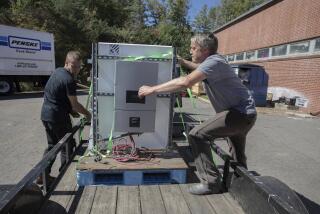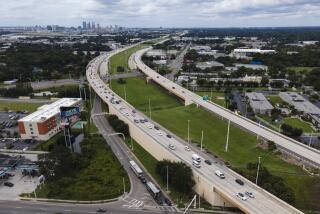Coastal N. Carolina Scats at Hurricane Emily’s Howl
- Share via
MOREHEAD CITY, N.C. — The early winds of Hurricane Emily keened across the North Carolina coast Monday night like a hungry cry, and authorities ordered 150,000 people to flee the shoreline and abandon a string of fragile barrier islands.
Businesses closed. Schools canceled classes. Fishermen moved their boats to safer harbor. Lumberyards sold out of plywood for boarding up windows. Residents who stayed to face the storm, which could hit as early as noon EDT today, did last-minute stocking up: food, water, batteries.
At 11 p.m. Monday, local time, Emily’s eye hovered about 225 miles southeast of Cape Hatteras. It was moving west-northwest at about 9 m.p.h., with winds gusting to 120 m.p.h. The storm was expected to swing slightly northward and gather strength as it swirled across warmer water in the Gulf Stream.
If it tarries and reaches land tonight or Wednesday morning, forecasters expect a particularly heavy swell. The hurricane could conspire with normal high tides at 8 p.m. or 9 a.m., as well as a full moon, which would add to the pull on the sea. Such a confluence could cause extensive flooding in the narrow, sandy salt marshes on the Outer Bank islands.
Emily’s sustained wind could reach more than 110 m.p.h. as it approaches the shore, forecasters said. That would give it less force than Hurricane Andrew, which struck Florida last year with sustained winds of 145 m.p.h. Andrew was the costliest natural disaster in U.S. history. It killed 41 people and caused $30 billion in damage.
“The question now is where it will turn to the north,” said Bob Sheets, director of the National Hurricane Center in Coral Gables, Fla. “It may turn to the north slightly inland--or off the coast.” If it does the latter, it would spare North Carolina. But then it would skim the eastern United States, terrorizing millions.
Sheets posted a hurricane warning from Bogue Inlet, 20 miles southwest of Morehead City, N.C., near the Marine Corps’ Camp Lejeune, to the Virginia state line. The warning means Emily might hit anywhere in that area anytime this afternoon.
He also posted a hurricane watch for a broader area, from Little River, S.C., near the North Carolina line, north to Fenwick Island, Del., near the Maryland-Delaware border. A watch is somewhat less serious. It means that hurricane conditions pose a threat.
Officials in both sectors took the warnings seriously.
The Navy moved 18 ships, including the aircraft carrier John F. Kennedy, from Norfolk Naval Base in Virginia to about 300 miles offshore. New River Air Station, Ft. Bragg and Pope Air Force Base in North Carolina planned to move aircraft to safer ground.
As swells climbed to 10 feet along the North Carolina coast, cars carrying tourists and residents alike clogged roads and highways leading away from the area.
One of the few people left on Cedar Island in the Outer Banks was Joe Gray, who works for the North Carolina Department of Transportation. The department operates a ferry that had taken most of the residents of isolated Ocracoke Island to Cedar Island, from where they were able to reach the Mainland by car.
Gray said he would spend the night on Cedar Island, where a historical marker says Blackbeard the Pirate was killed a few miles away in Pamlico Sound. Gray said he might leave in the morning if he had to.
Vicky Salter, standing in her front yard with daughter Michelle, 12, said she and her family would go partway to the Mainland and spend the night with in-laws. Salter has lived on Cedar Island for 17 years.
Like Gray, she said she would wait until morning to make a final decision about leaving the area altogether. But as she watched the moon rise beautifully but ominously, she added: “I kind of want to just get out of here.”
Alvah Goodwin, 76, a native Downeaster, as they call people from the lower Outer Bank, said he would stay.
Leave?
“I’m too old to even think about it.”
For Goodwin, a retired ferry operator, preparation for the storm amounted to very little. “I picked up a few things in the yard.”
Inland at Morehead City, residents figured they would be in Emily’s bull’s-eye. They boarded up virtually every shop window along Arendell Street, the main thoroughfare.
Then most of them obeyed the orders to flee.
Jerry Hardesty, 46, said he would be a holdout. He worked into the evening nailing plywood over the windows of his gun shop. Hardesty said he would take no chances with his inventory of weapons and military hardware.
“We’ll stay here tomorrow and through the night.” He nodded toward his store. “No one’s getting anything out of here, except maybe a funeral.”
He said his wife, Karen, would stay too. “She’s a better shot than I am.”
A bit to the east, in Beaufort, dock master Jeb Brearey said 75% to 80% of the boats that normally tie up in the harbor had left for the safety of creeks and rivers.
Brearey said he was taking in only boats that had no safer place to go.
But he said he was not particularly worried about hurricane winds at 100 m.p.h. “If it’s blowing 130 m.p.h., then I’m worried.
“But 85 m.p.h., I’m not. We get thunderstorms with winds that high.”
At Wrightsville Beach on the Outer Bank, just south of the warning area, Ed Taylor, a city planner, said some 10,000 residents had declined to leave.
“We’re just watching and waiting,” he said.
Norman Horton, 62, a telephone company manager from Long Island who retired in Wrightsville Beach four years ago, spent part of the afternoon fishing from a commercial pier.
Horton said he had bought drinking water, batteries, propane and canned goods. With that, he said, he was ready for anything. “I think everybody is taking this seriously. Some of my neighbors have boarded up already.”
But Horton seemed just as interested in the lack of fish as he was in the hurricane.
He cast a white plug into the sea and lamented that the storm seemed to be scaring away more fish than people.
“I think this thing’s affected the fish already,” he said. “They have already evacuated.”
Farther north, in Virginia Beach, Va., Bill Lockhart, a vacationer from Chantilly, Va., loaded his van with his children’s stuffed animals and said he was leaving to avoid traffic in the morning.
“Just like anytime you go to these places,” he said, “there’s one way in and one way out. We don’t want to get in any massive traffic jam tomorrow.”
His children, Lindsay, 4, Jessi, 12, and Dusty, 13, were reluctant to go, and they said so.
But staying, their father declared, “doesn’t sound like a wise decision.”
Keith and Tracy Barnes of Syracuse, N.Y., had arrived in Virginia Beach on Sunday for a weeklong honeymoon. Now it was over.
“We’re from New York, and we’re leaving,” Keith Barnes said. “When I see people boarding things up, I don’t plan to stay.”
At a public parking lot, attendant Tony Earles watched the rising surf through a pair of binoculars. “Looks like there’s a storm a-brewin’, that’s for sure.”
He wore a pair of surfer’s shorts, a gold chain and sunglasses. On Sunday, he said, the ocean had been “like a pond.” But by Monday afternoon, the waves climbed to between five and six feet high. And this, he allowed, was excellent surf.
The beaches had been closed by lifeguards, but when the lifeguards packed up at 6 p.m., surfers headed out into the water. Some ventured at least 100 feet out into the churning, steely gray waves. Earles watched enviously.
Before closing for the night, he and fellow attendant Norma Levinson, who was collecting $3 a car for evening parking, said they would tip their parking booth into the wind and make sure that all trash cans were tied down.
Gerstenzang is a Times staff writer and Clary is a special correspondent. Times staff writers Eric Harrison in New Bern, N.C., and Richard E. Meyer in Los Angeles contributed to this story.
Preparing for the Worst
Among the precautions taken as Hurricane Emily closed in on the North Carolina coast:
* Hurricane warning were issued from Bogue Inlet, N.C., to the North Carolina-Virginia border, including Albemarle and Pamlico sounds in North Carolina.
* Up to 100,000 people on North Carolina’s barrier islands were ordered to evacuate
* The Federal Emergency Management Agency set up a command post at Ft. Bragg, N.C.
* The Navy sent 21 warships to sea, including the aircraft carrier John F. Kennedy, to prevent damage.
More to Read
Sign up for Essential California
The most important California stories and recommendations in your inbox every morning.
You may occasionally receive promotional content from the Los Angeles Times.










